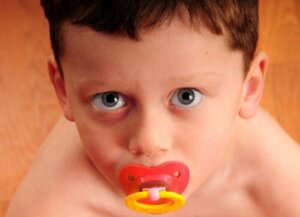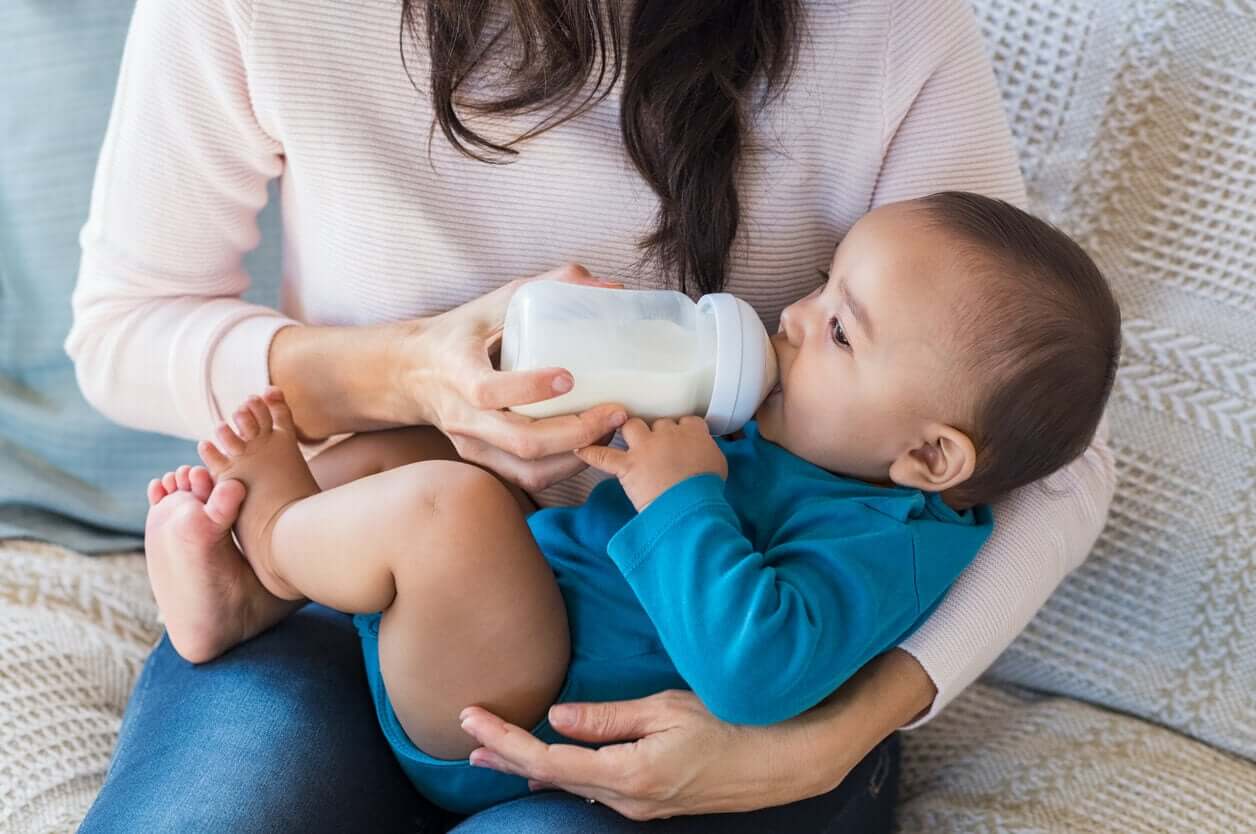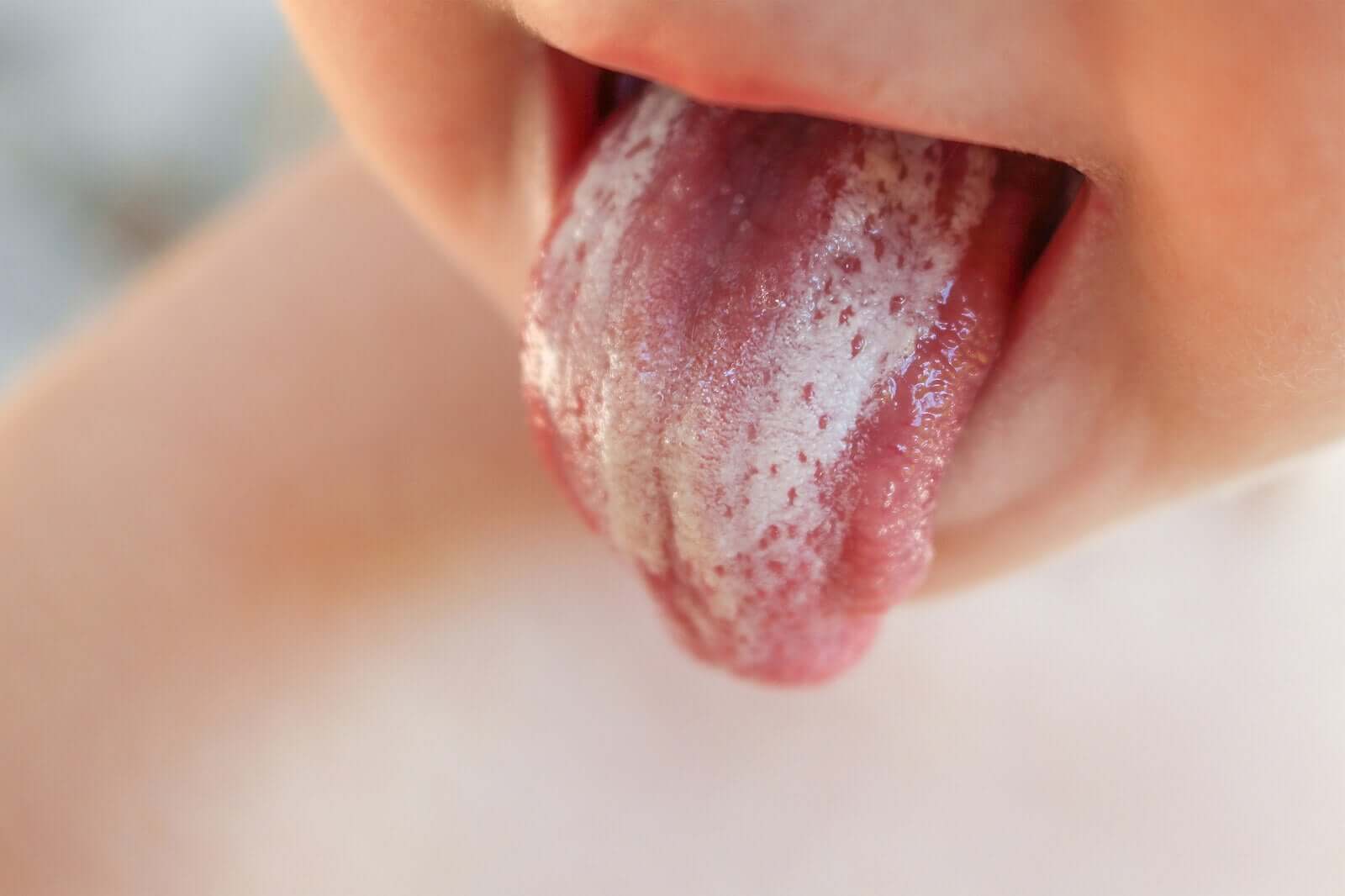The Dangers of the Prolonged Use of Bottles and Pacifiers

Did you know that the prolonged use of bottles and pacifiers beyond the recommended ages can be harmful to your baby? While these products aren’t harmful in and of themselves, their extended use is.
Both the bottle and the pacifier are good allies in the upbringing of some children and tend to become an inevitable part of the daily routine. But it’s important to put them to good use to avoid the appearance of certain mouth problems. We’ll tell you about them below.
The action of bottles and pacifiers in the mouth
The use of artificial nipples in babies, whether of bottles or pacifiers, is something quite naturalized and common. Despite this, not all parents are aware of their benefits or the possible damage to the mouth of their little ones.
Being in the baby’s oral cavity, the nipple triggers the sucking movements. This action can be nutritional (when feeding) or non-nutritional, which is used for relaxation purposes and even for the prevention of sudden death.
This product was designed to simulate the characteristics of the mother’s nipple, which adapts perfectly to the child’s mouth. However, the suction mechanism of the breast and the nipples is slightly different.
With the mother’s breast, the baby must exert some force and movements with their mouth to release their mother’s milk. This favors nutrition, growth, and the correct development of the orofacial structures.
On the contrary, when the baby is fed with a bottle, the process is much simpler, as they don’t need to make as much effort to obtain the food. In the long run, this can lead to hypotonia of the lips and tongue.
With regard to offering the pacifier, it’s best not to do so until breastfeeding is well established. Children who don’t use this element find other ways to calm themselves, such as non-nutritive sucking on the breast, on their hand, or on the tongue itself.

Changes in suction
As the baby grows, their diet evolves and changes. At around 6 months, the sucking reflex disappears and mealtime is already a learned and voluntary act. At this time, the incorporation of solid foods plays a fundamental role in changing the way a child swallows.
Therefore, up to 12 months, the use of a pacifier and a bottle are recommended. But after that age, it’s time to remove them and move on to drinking from a glass.
The dangers of the prolonged use of bottles and pacifiers
Not taking away bottles and pacifiers in time is associated with the development of certain dangers and negative effects in the mouths of children. Next, we’ll mention the most frequent consequences of their prolonged use.
1. Oral malocclusions
This is one of the most common dangers. That’s because the presence of the nipple between the teeth, the continuation of suction, and the lack of development of adequate swallowing limit the correct development of the orofacial structures.
Inadequate growth of the jaws results in narrower dental arches and deeper palates. This, in turn, gives rise to occlusion problems and dental malpositions, such as those detailed below:
- Open bite: This is the development of a narrow upper jaw, whose teeth don’t contact the lower ones. The upper incisors protrude outwards and there’s a space between the two arches that doesn’t complete the occlusion.
- Crossbite: Due to improper development, the dental arches bite in the opposite way to what’s normal. The lower dental elements remain outside the upper ones and cause the child aesthetic, phonetic, chewing, and digestive inconveniences.
- Alterations in the temporomandibular joint (TMJ): The dangers of suffering problems in this joint, such as dislocations or bruxism, are increased by the prolonged use of bottles and pacifiers.
- Dental malpositions: Prolonging the suction leads to the tongue pushing the teeth and encouraging them to come out crooked or move out of place.
In these cases, orthopedic and orthodontic treatments during childhood are usually necessary to reverse and treat these malocclusions.
2. Baby bottle tooth decay
Allowing a baby to sleep with their bottle in their mouth or wetting the pacifier with sweet substances promotes the development of early childhood cavities. This is a very aggressive form of the disease, as it quickly destroys milk teeth.
It’s produced by the permanence of the contact of sugar (from milk or other beverages) with the dental surfaces. If other sweeteners are also added, the problem’s much greater.
3. Soft tissue problems
Another danger of the prolonged use of bottles and pacifiers is the alteration of the orofacial muscles.
When performing movements that aren’t suitable for the child’s age and at the same time limiting those that are, an imbalance occurs in the structures of the face. These alterations are manifested through deformities, pain, or some of the following symptoms:
- Eversion of the lower lip: This structure falls outwards, as it doesn’t have the proper tone and causes problems when it comes to articulating the phonemes.
- Hypotonia of the tongue: A weak tongue, without strength, with low muscle tone, and little mobility brings complications when handling food in the mouth, swallowing, and articulating words.
4. Alteration of functions
Due to the malformations and imbalances that occur, various functions of the mouth can be affected. Among them, the following stand out:
- Speech: The articulation of certain phonemes isn’t possible due to problems in the lips, tongue, palate, or teeth. In turn, dyslalias can cause insecurity or low self-esteem in the child.
- Atypical swallowing: Prolonging the use of bottles and pacifiers contributes to the development of an abnormal swallowing mechanism. The child supports the tongue between their teeth to swallow and compensate the mouth closure with the muscles.
- Oral breathing: The use of a pacifier favors oral breathing, which gives rise to ogival palates.
- Alteration of the cervical-cranial posture: Alterations in swallowing and respiratory functions cause a poor position of the head and neck to compensate for the damage. This ends up affecting overall posture.
5. Infections
Continuous suction increases salivary production and this excess moisture favors the development of microorganisms in the mouth.
Oral candidiasis or thrush are some of the dangers associated with prolonged use of bottles and pacifiers. They manifest as whitish plaques on the corners of the lips or on the tongue.
In addition, taking the bottle in a horizontal position or maintaining constant suction can affect the functioning of the Eustachian tubes and predispose children to the development of recurrent otitis media.

Recommendations to avoid the dangers of prolonging the use of the bottle and pacifier
To avoid all the dangers of prolonging the use of the bottle and pacifier, removing these elements in time is the indicated solution. But in practice, this can become somewhat difficult.
Around 12 months, the child’s ready to drink from a glass and no longer use the bottle. Practicing the use of a cup from the beginning of the complementary feeding helps little ones to reach their first birthday with this skill mastered.
While using the bottle, it’s best to choose nipples with small outlet holes and low flow rates to stimulate the orofacial muscles. In addition, it’s best to feed little ones in an upright position and not lying down.
Pacifier use may continue for a longer time, but shouldn’t extend beyond 2 years of age. Therefore, it’s best to find other ways to calm the child, such as rocking them or singing a song.
Taking care of your child’s proper oral hygiene will also help prevent cavities. Likewise, you should avoid adding sugar to drinks and sweetening the nipples. Nor should you put the child to sleep with the bottle in their mouth and perform an oral cleaning after feeding, before putting them to bed.
In both cases, abandoning these attachment objects that provide pleasure and security is a great challenge for little ones. Therefore, it’s best to be respectful and anticipate the new situation in advance. It’s not something that happens overnight and you have to be patient because accompanying the process with love and calm is essential.
Did you know that the prolonged use of bottles and pacifiers beyond the recommended ages can be harmful to your baby? While these products aren’t harmful in and of themselves, their extended use is.
Both the bottle and the pacifier are good allies in the upbringing of some children and tend to become an inevitable part of the daily routine. But it’s important to put them to good use to avoid the appearance of certain mouth problems. We’ll tell you about them below.
The action of bottles and pacifiers in the mouth
The use of artificial nipples in babies, whether of bottles or pacifiers, is something quite naturalized and common. Despite this, not all parents are aware of their benefits or the possible damage to the mouth of their little ones.
Being in the baby’s oral cavity, the nipple triggers the sucking movements. This action can be nutritional (when feeding) or non-nutritional, which is used for relaxation purposes and even for the prevention of sudden death.
This product was designed to simulate the characteristics of the mother’s nipple, which adapts perfectly to the child’s mouth. However, the suction mechanism of the breast and the nipples is slightly different.
With the mother’s breast, the baby must exert some force and movements with their mouth to release their mother’s milk. This favors nutrition, growth, and the correct development of the orofacial structures.
On the contrary, when the baby is fed with a bottle, the process is much simpler, as they don’t need to make as much effort to obtain the food. In the long run, this can lead to hypotonia of the lips and tongue.
With regard to offering the pacifier, it’s best not to do so until breastfeeding is well established. Children who don’t use this element find other ways to calm themselves, such as non-nutritive sucking on the breast, on their hand, or on the tongue itself.

Changes in suction
As the baby grows, their diet evolves and changes. At around 6 months, the sucking reflex disappears and mealtime is already a learned and voluntary act. At this time, the incorporation of solid foods plays a fundamental role in changing the way a child swallows.
Therefore, up to 12 months, the use of a pacifier and a bottle are recommended. But after that age, it’s time to remove them and move on to drinking from a glass.
The dangers of the prolonged use of bottles and pacifiers
Not taking away bottles and pacifiers in time is associated with the development of certain dangers and negative effects in the mouths of children. Next, we’ll mention the most frequent consequences of their prolonged use.
1. Oral malocclusions
This is one of the most common dangers. That’s because the presence of the nipple between the teeth, the continuation of suction, and the lack of development of adequate swallowing limit the correct development of the orofacial structures.
Inadequate growth of the jaws results in narrower dental arches and deeper palates. This, in turn, gives rise to occlusion problems and dental malpositions, such as those detailed below:
- Open bite: This is the development of a narrow upper jaw, whose teeth don’t contact the lower ones. The upper incisors protrude outwards and there’s a space between the two arches that doesn’t complete the occlusion.
- Crossbite: Due to improper development, the dental arches bite in the opposite way to what’s normal. The lower dental elements remain outside the upper ones and cause the child aesthetic, phonetic, chewing, and digestive inconveniences.
- Alterations in the temporomandibular joint (TMJ): The dangers of suffering problems in this joint, such as dislocations or bruxism, are increased by the prolonged use of bottles and pacifiers.
- Dental malpositions: Prolonging the suction leads to the tongue pushing the teeth and encouraging them to come out crooked or move out of place.
In these cases, orthopedic and orthodontic treatments during childhood are usually necessary to reverse and treat these malocclusions.
2. Baby bottle tooth decay
Allowing a baby to sleep with their bottle in their mouth or wetting the pacifier with sweet substances promotes the development of early childhood cavities. This is a very aggressive form of the disease, as it quickly destroys milk teeth.
It’s produced by the permanence of the contact of sugar (from milk or other beverages) with the dental surfaces. If other sweeteners are also added, the problem’s much greater.
3. Soft tissue problems
Another danger of the prolonged use of bottles and pacifiers is the alteration of the orofacial muscles.
When performing movements that aren’t suitable for the child’s age and at the same time limiting those that are, an imbalance occurs in the structures of the face. These alterations are manifested through deformities, pain, or some of the following symptoms:
- Eversion of the lower lip: This structure falls outwards, as it doesn’t have the proper tone and causes problems when it comes to articulating the phonemes.
- Hypotonia of the tongue: A weak tongue, without strength, with low muscle tone, and little mobility brings complications when handling food in the mouth, swallowing, and articulating words.
4. Alteration of functions
Due to the malformations and imbalances that occur, various functions of the mouth can be affected. Among them, the following stand out:
- Speech: The articulation of certain phonemes isn’t possible due to problems in the lips, tongue, palate, or teeth. In turn, dyslalias can cause insecurity or low self-esteem in the child.
- Atypical swallowing: Prolonging the use of bottles and pacifiers contributes to the development of an abnormal swallowing mechanism. The child supports the tongue between their teeth to swallow and compensate the mouth closure with the muscles.
- Oral breathing: The use of a pacifier favors oral breathing, which gives rise to ogival palates.
- Alteration of the cervical-cranial posture: Alterations in swallowing and respiratory functions cause a poor position of the head and neck to compensate for the damage. This ends up affecting overall posture.
5. Infections
Continuous suction increases salivary production and this excess moisture favors the development of microorganisms in the mouth.
Oral candidiasis or thrush are some of the dangers associated with prolonged use of bottles and pacifiers. They manifest as whitish plaques on the corners of the lips or on the tongue.
In addition, taking the bottle in a horizontal position or maintaining constant suction can affect the functioning of the Eustachian tubes and predispose children to the development of recurrent otitis media.

Recommendations to avoid the dangers of prolonging the use of the bottle and pacifier
To avoid all the dangers of prolonging the use of the bottle and pacifier, removing these elements in time is the indicated solution. But in practice, this can become somewhat difficult.
Around 12 months, the child’s ready to drink from a glass and no longer use the bottle. Practicing the use of a cup from the beginning of the complementary feeding helps little ones to reach their first birthday with this skill mastered.
While using the bottle, it’s best to choose nipples with small outlet holes and low flow rates to stimulate the orofacial muscles. In addition, it’s best to feed little ones in an upright position and not lying down.
Pacifier use may continue for a longer time, but shouldn’t extend beyond 2 years of age. Therefore, it’s best to find other ways to calm the child, such as rocking them or singing a song.
Taking care of your child’s proper oral hygiene will also help prevent cavities. Likewise, you should avoid adding sugar to drinks and sweetening the nipples. Nor should you put the child to sleep with the bottle in their mouth and perform an oral cleaning after feeding, before putting them to bed.
In both cases, abandoning these attachment objects that provide pleasure and security is a great challenge for little ones. Therefore, it’s best to be respectful and anticipate the new situation in advance. It’s not something that happens overnight and you have to be patient because accompanying the process with love and calm is essential.
All cited sources were thoroughly reviewed by our team to ensure their quality, reliability, currency, and validity. The bibliography of this article was considered reliable and of academic or scientific accuracy.
- Sánchez, L. M., González, E. D., Florensa, S. G. T., & Marti, J. G. (2000, January). Uso del chupete: beneficios y riesgos. In Anales de Pediatría (Vol. 53, No. 6, pp. 580-585). Elsevier Doyma.
- Cahuana, A., Palma, C., González, Y., & Palacios, E. (2016). Salud bucodental materno-infantil.¿ Podemos mejorarla?. Matronas profesión. Matronas Prof, 17(1), 12-19.
- Bryson, T. P. (2021). El abecé del recién nacido: Una guía esencial que responde a las principales dudas y preocupaciones de la crianza de bebés y niños pequeños. ALBA Editorial.
- Revelo Navarrete, C. E. (2019). Prevalencia y severidad de caries de la primera infancia y sus factores de riesgo en niños de edad preescolar (Bachelor’s thesis, Quito: UCE).
- Claros Navarrete, S. D. (2021). Prevalencia de caries de biberón (Bachelor’s thesis, Universidad de Guayaquil. Facultad Piloto de Odontología).
- Campoverde, L. A. G., Soto, A. R., & Cantero, L. S. (2020). Factores de riesgo de la malocusión. Medicentro Electrónica, 24(4), 753-766.
- Illescas, M. V. L., Soto, A. R., & González, B. G. (2019). Maloclusiones dentarias y su relación con los hábitos bucales lesivos. Revista Cubana de Estomatología, 56(2), 1-14.
- Suasnavas Pazmiño, P. F. (2021). Relación entre el tipo de lactancia y la succión no nutritiva con la maloclusión en la primera infancia. Revisión de literatura (Doctoral dissertation, Quito: Universidad Hemisferios 2021).
- Moscardó, M. F. B. (2019). Relación de la maloclusión con los hábitos de succión nutritivos y no nutritivos (Doctoral dissertation, Universidad de Alcalá).
This text is provided for informational purposes only and does not replace consultation with a professional. If in doubt, consult your specialist.








